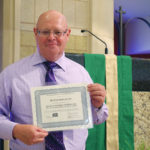By Mara Adams
SAU Theological Perspective

October is a beautiful month in the Midwest: the trees are sporting their fall foliage colors and the morning air is crisp without the heaviness of summer humidity. Science tells us that cool autumn weather reveals nature’s true color of leaves and we’d be mistaken if we assume that the green is the essential color of the leaves.
It is also easy to mistake the essential character of several saints whose feast days we celebrate in October, including Francis of Assisi (10/4), Therese of Lisieux (10/1) and Teresa of Avila (10/15). Because of their popularity, it is easy to assume that we know most of the important aspects of their lives. However, their complexity can be overlooked when we reduce them to a few well-known tropes.
For example, Francis of Assisi is the world’s most known saint next to the Virgin Mary. He’s claimed by those in the fields of ecology, feminism and animal-rights movement; in 1979, Pope John Paul II proclaimed Francis the patron of ecology. Francis was a man of contrast, talents and quirks. He was not an effective administrator, he was known for being funny and playful to the point that many thought he was mad, and he frequently made exceptions to the rules.
In his youth, Francis lived the life of a self-indulgent young man, dreaming of glory on the battlefield and knighthood. At age 21, he went to war and in a battle between Assisi and Perugia was captured, became ill, and spent nearly a year in prison waiting for his father to pay his ransom. Francis returned home exhausted, sick and disillusioned with his former life. He renounced his inheritance and took up an itinerant lifestyle. In additional to ecological and sustainability concerns, Francis is an example of spiritual renewal in the face of great social and religious division. He is a saint for those concerned about economic and social justice for the disenfranchised and a cautionary tale about moral injury and the devastation of war.
Like Francis, Therese of Lisieux sought a simple life and might have remained unknown had she not left behind notes that her sister Pauline edited and published as “The Story of a Soul.” Therese’s mother died when she was a toddler, which altered the course of her childhood and left her with issues of abandonment and rejection.
Paul encourages the Christian community of Thessalonica to “aspire to lead a quiet life (1 Thes 4:11),” which he viewed as the antidote to the strife that troubled that community. Paul’s analogy of the body of Christ reminds us that building God’s Kingdom involves many kinds of tasks done by many people — and all of them have value. It is a faulty human perspective that causes us to look askance on those whose work in life is unglamorous, poorly compensated or done in relative anonymity. Intent on pursuing a quiet life in obscurity, Therese is the saint for anyone who’s ever wondered about the value of their life’s work.
Three centuries before Therese of Lisieux, another Carmelite member, Teresa of Avila, also sought a contemplative life. Like Francis and Therese, Teresa of Avila became a central figure in the spiritual and monastic renewal movement that advocated ascetical practices and challenged institutional corruption. Teresa’s strength and determination were negatively characterized by those who believed women should not have a public role. Religious historian R. P. Hsia notes that a Vatican representative described Teresa as a stubborn woman who challenged authority and defied Paul’s prohibition against women engaged in teaching. Opposition to her reform efforts were so fierce that a case against her was brought to the Inquisition court and she was forced to stop her work and remain at St. Joseph’s monastery. This prolonged opposition took a toll on Teresa, who also was plagued with illness and self-doubts over what she called her own mediocrity. Teresa is the saint for anyone who’s ever felt discouraged about trying to do the right thing when it’s the hard thing. She and Therese of Lisieux, who were both given the title of Doctor of the Church, are also models for marginalized voices, including those of women, who seek to be heard and respected.
Both Saints John XXIII and John Paul II’s feast days are in October and while there is too much to say about them in this column, they are powerful exemplars for the vibrancy, creativity and wisdom so often overlooked in older people. Like Francis, their experiences with war affected them deeply; like Teresa, they sought reform, and like Therese, they found their strength in prayer, silence and maintaining a contemplative element in their very public lives.
These saints had complexity and depth that cannot be reduced to pious caricatures. They were deeply concerned for the lives of the most vulnerable, passionate about building God’s Kingdom and brave enough to cling to God during their darkest hours. May we continue to be inspired by them during this beautiful fall season.
(Mara Adams is a professor of theology at St. Ambrose University in Davenport where she also coordinates service learning.)











